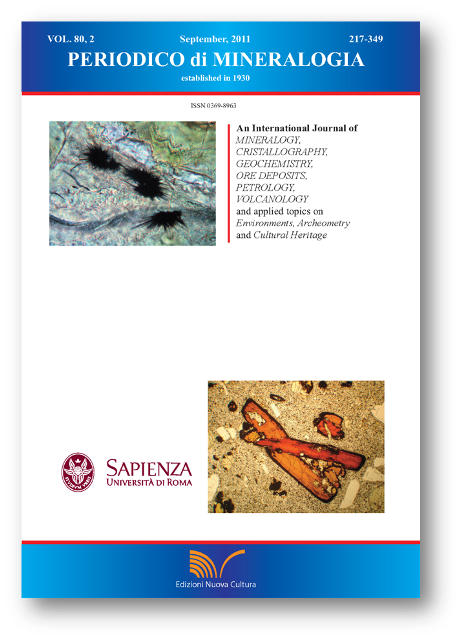A case study of alkali-silica reactions: petrographic investigation of paving deterioration
DOI:
https://doi.org/10.2451/2011PM0022Keywords:
Alkali-aggregate reaction, petrography, microstructure, SEM-EDX.Abstract
Periodico di Mineralogia (2011), 80, 2, 309-316 - DOI:10.2451/2011 PM0022
A case study of alkali-silica reactions:
petrographic investigation of paving deterioration
Giorgio Gasparotto1,*, Giuseppe Maria Bargossi1, Fausto Peddis2 and Valentina Sammassimo1
1Dipartimento di Scienze della Terra e Geologico-Ambientali, Università di Bologna, Piazza Porta S. Donato 1, 40126 Bologna, Italy
2Dipartimento di Ingegneria Civile, Ambientale e dei Materiali, Università di Bologna, Via Terracini 28, 40131 Bologna, Italy
*Corresponding author: giorgio.gasparotto@unibo.it
Abstract
Alkali-silica reactions are one of the most common causes of deterioration of concrete. This paper presents a petrographic study of a damaged paving situated in Bologna (North Italy) where alkali silica reactions produced diffused pop-out of cm-sized chips. Siliceous limestone, chert and flint present in the aggregate did not show any reactivity; alkali-silica reactions developed only from fine-grained silica rich marls. Reactive grains show an evident zonation with fractured cores and more compact rims. ASR produced mobilization
of alkalies towards the interior of reactive grains coupled with mobilisation of Ca2+ ions wichre-precipitate and react with alkali-silica rich fluids to produce a hard rim. The final effect is the cracking of the grain due to accumulated gels inside. Alkali-silica reactions developed only on the flooring exposed to capillary rise of water. A further proof of the reactivity of these fine-grained marly grains is the late-stage formation on their surface of Na-carbonate.
Key words: Alkali-aggregate reaction; petrography; microstructure; SEM-EDX.


